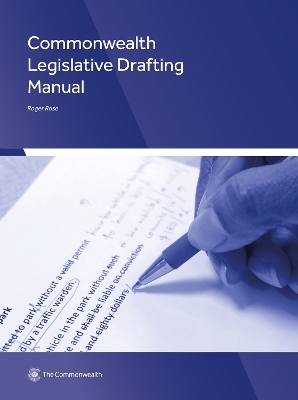
Commonwealth Legislative Drafting Manual
Commonwealth Secretariat (Verlag)
978-1-84929-169-9 (ISBN)
In 1976, recognising that there was a shortage of trained legislative drafters in the Commonwealth, the Commonwealth Secretariat first published a legislative drafting manual aimed at informing those practitioners with little or no previous experience in the skill, and assisting those with some experience who had never considered why drafting needed to be undertaken in a particular way.
That aim remains, but more than 40 years later there have been important changes in the way legislation is drafted. These mainly concern the perceived need to make it more accessible to those to be affected by it, in particular by the use of plain language and sentence structures that relate more closely to those used in formal nonlegislative documents.
In the light of these and other changes, the Commonwealth Legislative Drafting Manual has been completely rewritten, and it now guides the practitioner step by step through the various things he or she needs to know. It also contains a series of appendices relating to the procedure for the preparation of legislation, the contents of drafting instructions, and some hints to the beginner on the best approaches to the task.
Foreword
Preface
Acknowledgements
1. What is Legislation and why is it Drafted the Way it is?
1.1 What is legislation?
1.2 How is legislation created?
1.3 Why is legislation drafted in the way it is?
Note
2. The Role of Legislative Counsel
2.1 Analysis and understanding of what the policy-makers require
2.2 Effective communication of the intentions of the policy-makers
2.3 Specific attributes of effective communication
2.4 Constraints on legislative counsel
3. Background Legislation
3.1 The Constitution
3.2 The Anterpretation Act
Note
4. The Basic Elements of a Legislative Sentence
4.1 Legal subject
4.2 Legal action
4.3 Context
4.4 Prominence for the legal subject
4.5 Prominence for the legal action
5. Modern Commonwealth Conventions in Legislative Drafting
5.1 The need for consistency and conciseness
5.2 Who is affected by the rule?
5.3 What is required or permitted?
Note
6. Plain Language Drafting
6.1 Introduction
6.2 Reasons why legislation may fail to communicate clearly
6.3 General objective of plain English in drafting legislation
6.4 The most common specific problems that need to be addressed
6.5 The aims of plain English in legislation
Notes
7. Structuring Legislative Drafts
7.1 Sentences
7.2 Paragraphs
7.3 Grouping provisions in an Act
7.4 Linking devices
8. Punctuation (and Capitalisation)
8.1 Full stop
8.2 Colon
8.3 Dash
8.4 Semi-colon
8.5 Quotation marks (or inverted commas)
8.6 Brackets
8.7 Hyphen
8.8 Apostrophe
8.9 Comma
8.10 Capital letters
Note
9. Definitions and Interpretation Provisions
9.1 Introduction
9.2 Definitions and other interpretation provisions generally
9.3 Different kinds of interpretation provisions and definitions
9.4 Writing definitions
9.5 Where particular care is needed in definitions
9.6 Where do interpretation provisions go?
10. Words to use With Special Care (and Other Drafting Problems)
10.1 Introduction
10.2 ‘And’ and ‘Or’
10.3 ‘Which’ and ‘that’
10.4 ‘All’, ‘any’, ‘each’ and ‘every’
10.5 ‘Such’
10.6 Singular and plural
10.7 Elliptical writing (omission of words which are to be implied)
10.8 Indeterminate terms
10.9 Gender-Neutral Drafting
10.10 Expressing time
10.11 Expressing numbers
11. The Legislative Scheme: Principles governing the type of legislation required and the ordering of its provisions
11.1 Fundamental questions to be answered
11.2 A logical structure to legislation
11.3 The logical sequence of sections within a Part
12. Preliminary Provisions
12.1 Introductory Provisions
12.2 Preliminary provisions
13. Final Provisions
13.1 Repeals
13.2 Transitional and savings provisions
13.3 Schedules
14. Penal Provisions
14.1 General formulae
14.2 Different types of penalties
14.3 Parties to offences
14.4 Strict liability in criminal law
14.5 Shifting the burden of proof
14.6 General matters concerning offences and penalties
14.7 Other matters consequent on conviction
14.8 Administrative penalties
15. Delegated Powers to Make Legislation
15.1 Why are powers to legislate delegated?
15.2 What form does subsidiary legislation take?
15.3 Questions about delegation which need to be considered by legislative counsel
15.4 How does the legislature supervise the making of subsidiary legislation?
15.5 Drafting subsidiary legislation
15.6 Typical layouts of subsidiary legislation, and executive instruments that are in some jurisdictions treated as subsidiary legislation
Note
16. Amending Legislation
16.1 How may statutes be amended?
16.2 Direct (or textual) and indirect methods of amending
16.3 Substantive and consequential amendments
16.4 Amendment, or repeal and replacement?
16.5 Retrospectivity of amendments
16.6 Drafting textual amendments
16.7 Renumbering
16.8 Punctuation
16.9 Indentation and spacing
16.10 Style
17. Specific Types of Application
17.1 Retrospective and retroactive provisions
17.2 Extra-territorial legislation
17.3 Binding the government
18. Statutory Corporations
18.1 Functions of statutory corporations
18.2 Terminology traditionally used
18.3 Corporate or non-corporate?
18.4 Features of a body corporate
18.5 Establishment of a body corporate
18.6 Drafting provisions to establish a statutory corporation
19. Licensing Legislation
19.1 Introduction
19.2 The purposes of licensing and registration
19.3 The contents of licensing legislation
19.4 Typical transitional and savings provisions relating to licences
20. Financial Legislation
20.1 Introduction
20.2 Government accounting
20.3 Government expenditure
20.4 Government borrowing, guarantees and lending
20.5 Taxation
Appendix A: Legislative Procedure and Preparation
Appendix B: Guidelines for the Preparation of Cabinet Submissions
Appendix C: Drafting Instructions
Appendix D: Suggested Approaches to Translation of Policy
Appendix E: Suggested Approaches to Drafting
| Erscheinungsdatum | 25.02.2018 |
|---|---|
| Verlagsort | London |
| Sprache | englisch |
| Maße | 190 x 253 mm |
| Themenwelt | Recht / Steuern ► Allgemeines / Lexika |
| Recht / Steuern ► Arbeits- / Sozialrecht ► Sozialrecht | |
| Recht / Steuern ► EU / Internationales Recht | |
| Recht / Steuern ► Öffentliches Recht | |
| ISBN-10 | 1-84929-169-1 / 1849291691 |
| ISBN-13 | 978-1-84929-169-9 / 9781849291699 |
| Zustand | Neuware |
| Haben Sie eine Frage zum Produkt? |
aus dem Bereich


